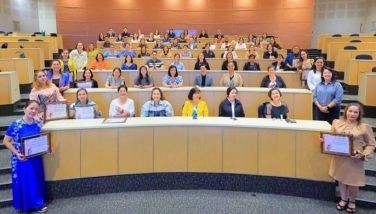4th year report of Ifugao Rice Terraces master plan 2003-2012
Last week, Ifugao Governor Teddy Baguilat and his team did a three-day review of the conservation efforts of the province that should help remove the Rice Terraces from the UNESCO List of World Heritage in Danger. This is timely for the exchange visit of the Italian delegation who looks after the ancient terraces of vineyards and olive trees on the Ligurian mountains of north Italy.
By early December, this year, the World Heritage Committee Director Francesco Bandarin will join the Italian experts to consolidate plans of conservation efforts of the “twinning project” of the two World Heritage Sites (WHS) of Ifugao Rice Terraces (IRT) and Cinque Terre, the vineyard and olive terraces of five coastal villages hanging on the mountain cliffs overlooking the Italian Riviera, two hours away from Genoa.
For 10 days, from the third week of May, I led the Philippine delegation, made up of Governor Baguilat, Hungduan Mayor Pablo Cuhayon and Architect Joyce Mananghaya, our UNESCO commissioner who has been helping complete the dossiers of our five World Heritage Sites in the Philippines, to observe and experience how the Cinque Terre vineyards have recovered within 10 years only from similar problems besetting the IRT, such as the abandonment of the vineyards and the weakening of its economic sustainability. It has become one of the most famous destinations of American, European, Australian, and even Chinese backpackers, young and old.
Rousing speeches from committed Ifugao experts
Although I gave the “Inspirational Talk”, I was stimulated by the committed Ifugao speakers led by Architect Rachel Guimbatan, Project Coordinator of Nurturing Indigenous Knowledge Experts (NIKE), who together with the NIKE writers of the Ifugao State College Agriculture and Forestry (ISCAF) wrote the 173-page Ifugao Indigenous Knowledge Textbook-Workbook “before the old folks go… let them see their knowledge live on.”
Gov. Baguilat reported on the “State of the IRT World Heritage Conservation Program”, while Engr. Carmelita Buyuccan presented the IRT Summit background.
Ms. Esther Licnachan of SITMO (Save the Ifugao Terraces Movement) spoke on “Systems of Rice Intensification”. Ms. Maribelle Bimohya of the Ifugao Provincial Council for Cultural Heritage talked about the “Safeguard and Management of the Ifugao Indigenous Oral Traditions”. Professor Eric Zerudo of the University of Santo Tomas spoke on “Developing Infrastructure Guidelines for Vernacular Houses in the IRT”.
Dr. Margaret Calderon of the University of the Philippines Los Banos discussed the “Sustainable Financing Mechanism for the IRT WHS”, a six-month survey of young and old Ifugaos funded by the Economy and Environment Program for Southeast Asia (EEPSEA). Mr. Robert Pangod of the Montanosa Research Development Center explained the “Implication to the IRT Conservation of Climate Change”.
Pluses and minuses of the IRT report
Four years after the crafting of the 10-year IRT Master Plan 2003-2012, a review of reports were done to gauge the level of commitment from the different sectors to preserve the 2,000-year old natural and cultural heritage of the Philippines. This review included individual reports of municipal local government units (LGUs), departments in the Provincial government, one non-government organization (NGO), and national government agencies. Prior to data collection and consolidation, the Provincial Planning and Development Office (PPDO) conducted a workshop to gather data on development activities since 2003 related to the IRT Master Plan.
Majority of the stakeholder offices and funding agencies responded to the call. However, a number of inconsistencies and missing data in some of them have affected the accuracy of the results. Of special note is the lack of update on specific infrastructure projects per municipality. While lumping different types of infrastructure under general themes such as “social infra” or “agri support” may seem to enhance the documents, concrete description of projects were missing.
Another limitation of this review is that it only used quantitative data, not qualitative, without actual site validation that would have evaluated the goal of achieving quality standards. Finally, of the different offices and agencies that responded, only a few truthfully filled the necessary data needed, in spite of the bureaucratic inertia. Several, however, did not bother to give any report at all.
IRT budget projection vs. actual expenditures
The review is composed of two parts. The first involves comparison of the budget for period starting 2003 up to 2008 against real expenditure. The second part, the review of physical outputs and accomplishments, were validated and cross-checked with the IRT MP.
In terms of actual expenditures, total is P287.562 million, way below the pegged budgetary cost of P543.35M or a deficit of 47.1 percent. Bulk went to Infrastructure support, almost 79 percent of the total. Apart from Sustainable tourism, and Social service & development expenditures which exceeded the IRT MP budgets at 109.6 percent and 143 percent respectively, all other sub-components fell short from 55 percent to a low of 5 percent. Least budgeted are Resource mobilization & institutionalization, Education for development, and Buffer zone development.
Bio-physical components of the IRT
The bio-physical component of the IRT includes four sub-component programs to maintain the Terraces status as World Heritage Sites, namely:
Community-Based Land Use, Physical Planning and Zoning Program – the Provincial Government as the coordinator and spearheading agency had an aggregate budget of P4.242M. Despite the limited funds, the stakeholders were able to accomplish the following: 12 ordinances and policies adopting and approving the implementation of formulated Community-based Land Use Plans (CLUPs) and Barangay Development Plans (BDPs). As a result, out of the nearly 180 barangays in Ifugao, nine have CLUPs, 31 have BDPs and 11 CBMs were established.
Biodiversity Restoration and Conservation Program – A great portion of the budget of P2.92M was allocated for the propagation and preservation of endemic and indigenous species. Other projects involve the delineation of forest lands, identification, inventory and documentation of Ifugao flora and fauna.
Community-based Forest Management Programs – The P19.345M budget was used to undertake programs, such as community consultations with terrace communities on reviving the traditional forest and agricultural management practices of the Ifugaos. Agro-forestry projects, including Tinawon rice, banana and coffee production and development of marketable by-products, such as highland herbal tea, rice wine, taro cassava polvoron, fruit cupcakes, lemon grass oil, and dried tilapia can augment farmers’ household income.
Hazards Management Program – With the rice terraces situated on more than 50 percent of the slopes of steep mountains, disasters and dangers are expected to occur anytime, especially during inclement weather. The P5.627 budget was used for efforts focused on stabilizing hazard-prone areas and training to equip concerned groups when disaster strikes.
Socio-cultural component
Indigenous Knowledge Systems, Cultural Development Transfer Program – No data were submitted on Agricultural Productivity Enhancement Program. However, it may not necessarily mean zero effort. It should be noted that the P3.29M budget went to Cultural Products and Organization Programs, such as festival celebrations, as well as Database Development.
Institutional Development – With a budget of P0.96M, programs focused on Policy Development and Advocacy, as well as Organizing and Capacity Building Programs, including development and marketing of OTOP (One Town, One Product) products.
Community-based agri industry
For Community-based Agri-Industry, the report revealed that the target was not met: Only three of the projected seven products were developed and marketed; no marketing support centers was created; only four of the 270 hectares of organic farms were established; three of the 10 researches were done; and 50 of the 80 trainings were conducted. There was no mention of cooperatives for Tinaon rice and wine. Energy sourcing should also have been described, specially the mini-hydro power project in Kiangan.
For Sustainable Tourism Development Programs, only 12 of the 19 activities were done, among which is the development and enhancement of mountain climbing and trekking destinations. Simple promotion and marketing elements were lacking, such as maps and signages. This should have included establishment of bed and breakfast accommodations. A comprehensive Ifugao Living Village is also needed where tourists can see Ifugao family day-to-day activities, weavers, carvers, complete with eateries selling gift packs of delicacies, and cultural craft stores. Botanical gardens of endemic Ifugao ferns and orchids should also be set up.
Only 4 more years remain
Six years into the 10-year IRT Master Plan and only four more years remain. To be able to achieve the goals and objectives, stakeholders need to work not just twice nor thrice but quadruple their usual speed and dedication in the allocation, mobilization of resources, and implementation of development endeavors for the conservation of the Ifugao Rice Terraces, the only World Heritage Site in the province.
(For more information or reaction, please e-mail at [email protected] or [email protected])
- Latest
























